
- •Instruction Set Nomenclature
- •I/O Registers
- •The Program and Data Addressing Modes
- •Conditional Branch Summary
- •Complete Instruction Set Summary
- •ADC – Add with Carry
- •ADD – Add without Carry
- •ADIW – Add Immediate to Word
- •AND – Logical AND
- •ANDI – Logical AND with Immediate
- •ASR – Arithmetic Shift Right
- •BCLR – Bit Clear in SREG
- •BLD – Bit Load from the T Flag in SREG to a Bit in Register
- •BRBC – Branch if Bit in SREG is Cleared
- •BRBS – Branch if Bit in SREG is Set
- •BRCC – Branch if Carry Cleared
- •BRCS – Branch if Carry Set
- •BREAK – Break
- •BREQ – Branch if Equal
- •BRGE – Branch if Greater or Equal (Signed)
- •BRHC – Branch if Half Carry Flag is Cleared
- •BRHS – Branch if Half Carry Flag is Set
- •BRID – Branch if Global Interrupt is Disabled
- •BRIE – Branch if Global Interrupt is Enabled
- •BRLO – Branch if Lower (Unsigned)
- •BRLT – Branch if Less Than (Signed)
- •BRMI – Branch if Minus
- •BRNE – Branch if Not Equal
- •BRPL – Branch if Plus
- •BRSH – Branch if Same or Higher (Unsigned)
- •BRTC – Branch if the T Flag is Cleared
- •BRTS – Branch if the T Flag is Set
- •BRVC – Branch if Overflow Cleared
- •BRVS – Branch if Overflow Set
- •BSET – Bit Set in SREG
- •BST – Bit Store from Bit in Register to T Flag in SREG
- •CALL – Long Call to a Subroutine
- •CBI – Clear Bit in I/O Register
- •CBR – Clear Bits in Register
- •CLC – Clear Carry Flag
- •CLH – Clear Half Carry Flag
- •CLI – Clear Global Interrupt Flag
- •CLN – Clear Negative Flag
- •CLR – Clear Register
- •CLS – Clear Signed Flag
- •CLT – Clear T Flag
- •CLV – Clear Overflow Flag
- •CLZ – Clear Zero Flag
- •COM – One’s Complement
- •CP – Compare
- •CPC – Compare with Carry
- •CPI – Compare with Immediate
- •CPSE – Compare Skip if Equal
- •DEC – Decrement
- •EICALL – Extended Indirect Call to Subroutine
- •EIJMP – Extended Indirect Jump
- •ELPM – Extended Load Program Memory
- •EOR – Exclusive OR
- •FMUL – Fractional Multiply Unsigned
- •FMULS – Fractional Multiply Signed
- •FMULSU – Fractional Multiply Signed with Unsigned
- •ICALL – Indirect Call to Subroutine
- •IJMP – Indirect Jump
- •IN - Load an I/O Location to Register
- •INC – Increment
- •JMP – Jump
- •LD – Load Indirect from Data Space to Register using Index X
- •LD (LDD) – Load Indirect from Data Space to Register using Index Y
- •LD (LDD) – Load Indirect From Data Space to Register using Index Z
- •LDI – Load Immediate
- •LDS – Load Direct from Data Space
- •LPM – Load Program Memory
- •LSL – Logical Shift Left
- •LSR – Logical Shift Right
- •MOV – Copy Register
- •MOVW – Copy Register Word
- •MUL – Multiply Unsigned
- •MULS – Multiply Signed
- •MULSU – Multiply Signed with Unsigned
- •NEG – Two’s Complement
- •NOP – No Operation
- •OR – Logical OR
- •ORI – Logical OR with Immediate
- •OUT – Store Register to I/O Location
- •POP – Pop Register from Stack
- •PUSH – Push Register on Stack
- •RCALL – Relative Call to Subroutine
- •RET – Return from Subroutine
- •RETI – Return from Interrupt
- •RJMP – Relative Jump
- •ROL – Rotate Left trough Carry
- •ROR – Rotate Right through Carry
- •SBC – Subtract with Carry
- •SBCI – Subtract Immediate with Carry
- •SBI – Set Bit in I/O Register
- •SBIC – Skip if Bit in I/O Register is Cleared
- •SBIS – Skip if Bit in I/O Register is Set
- •SBIW – Subtract Immediate from Word
- •SBR – Set Bits in Register
- •SBRC – Skip if Bit in Register is Cleared
- •SBRS – Skip if Bit in Register is Set
- •SEC – Set Carry Flag
- •SEH – Set Half Carry Flag
- •SEI – Set Global Interrupt Flag
- •SEN – Set Negative Flag
- •SER – Set all Bits in Register
- •SES – Set Signed Flag
- •SET – Set T Flag
- •SEV – Set Overflow Flag
- •SEZ – Set Zero Flag
- •SLEEP
- •SPM – Store Program Memory
- •ST – Store Indirect From Register to Data Space using Index X
- •ST (STD) – Store Indirect From Register to Data Space using Index Y
- •ST (STD) – Store Indirect From Register to Data Space using Index Z
- •STS – Store Direct to Data Space
- •SUB – Subtract without Carry
- •SUBI – Subtract Immediate
- •SWAP – Swap Nibbles
- •TST – Test for Zero or Minus
- •WDR – Watchdog Reset

Instruction Set Nomenclature
Status Register (SREG)
SREG: Status Register
C:Carry Flag
Z:Zero Flag
N:Negative Flag
V:Two’s complement overflow indicator
S:N V, For signed tests
H:Half Carry Flag
T:Transfer bit used by BLD and BST instructions
I:Global Interrupt Enable/Disable Flag
Registers and Operands
Rd: |
Destination (and source) register in the Register File |
Rr: |
Source register in the Register File |
R:Result after instruction is executed
K:Constant data
k:Constant address
b:Bit in the Register File or I/O Register (3-bit)
s: Bit in the Status Register (3-bit) X,Y,Z: Indirect Address Register
(X=R27:R26, Y=R29:R28 and Z=R31:R30)
A:I/O location address
q:Displacement for direct addressing (6-bit)
8-bit |
Instruction Set |
Rev. 0856D–AVR–08/02 |
1 |

I/O Registers
RAMPX, RAMPY, RAMPZ
Registers concatenated with the X-, Y-, and Z-registers enabling indirect addressing of the whole data space on MCUs with more than 64K bytes data space, and constant data fetch on MCUs with more than 64K bytes program space.
RAMPD
Register concatenated with the Z-register enabling direct addressing of the whole data space on MCUs with more than 64K bytes data space.
EIND
Register concatenated with the instruction word enabling indirect jump and call to the whole program space on MCUs with more than 64K bytes program space.
Stack
STACK: Stack for return address and pushed registers
SP: |
Stack Pointer to STACK |
Flags
: Flag affected by instruction
0: Flag cleared by instruction
1: Flag set by instruction
-: Flag not affected by instruction
2 AVR Instruction Set
0856D–AVR–08/02
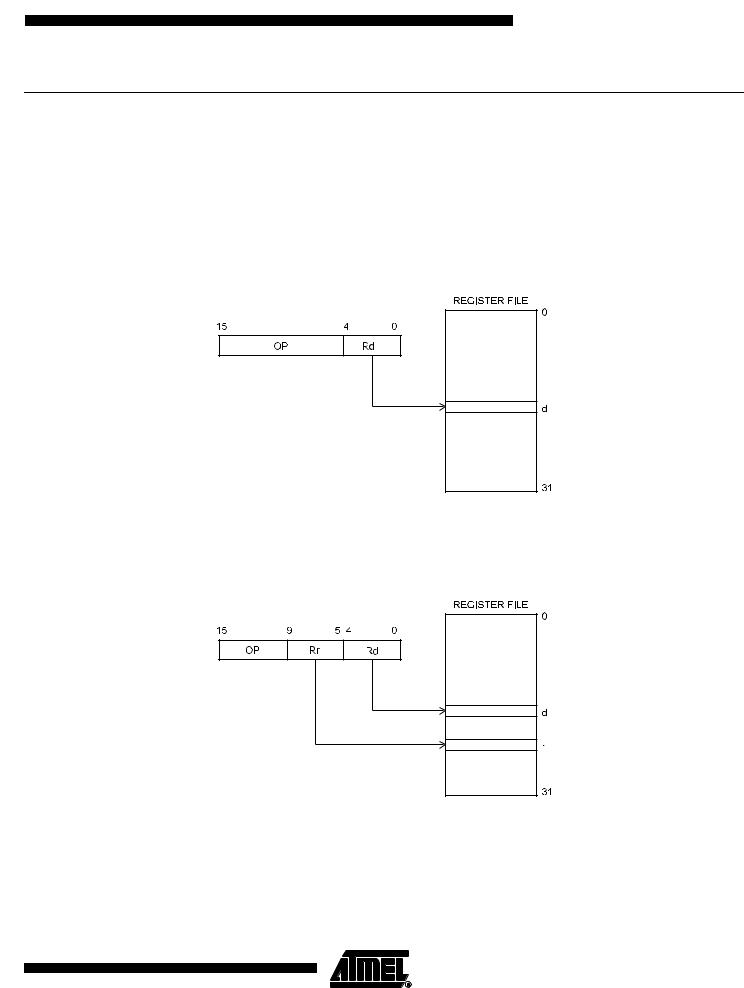
AVR Instruction Set
The Program and Data Addressing Modes
The AVR Enhanced RISC microcontroller supports powerful and efficient addressing modes for access to the Program memory (Flash) and Data memory (SRAM, Register file, I/O Memory, and Extended I/O Memory). This section describes the various addressing modes supported by the AVR architecture. In the following figures, OP means the operation code part of the instruction word. To simplify, not all figures show the exact location of the addressing bits. To generalize, the abstract terms RAMEND and FLASHEND have been used to represent the highest location in data and program space, respectively.
Note: Not all addressing modes are present in all devices. Refer to the device spesific instruction summary.
Register Direct, Single Register Rd
Figure 1. Direct Single Register Addressing
The operand is contained in register d (Rd).
Register Direct, Two Registers Rd and Rr
Figure 2. Direct Register Addressing, Two Registers
Operands are contained in register r (Rr) and d (Rd). The result is stored in register d (Rd).
3
0856D–AVR–08/02
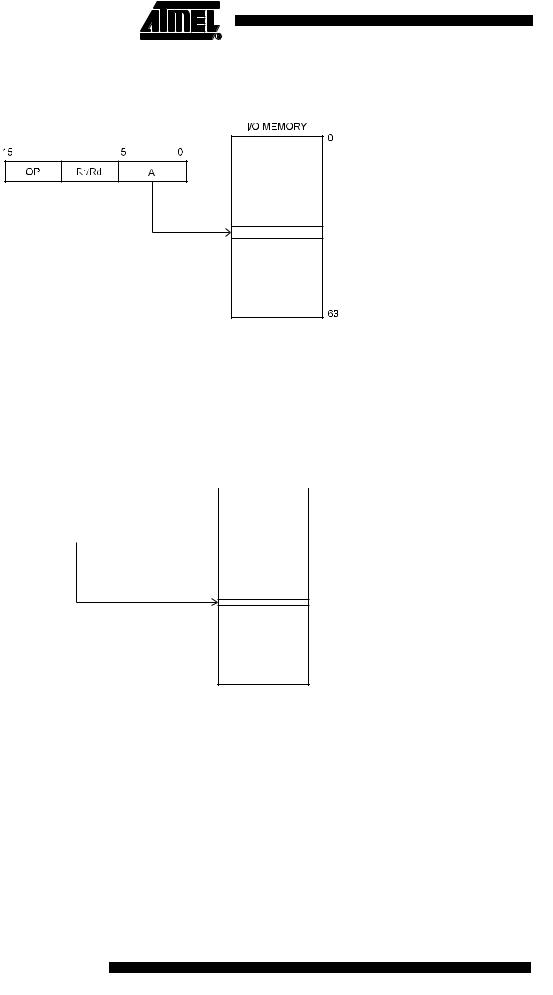
I/O Direct
Figure 3. I/O Direct Addressing
Operand address is contained in 6 bits of the instruction word. n is the destination or source register address.
Note: Some complex AVR Microcontrollers have more peripheral units than can be supported within the 64 locations reserved in the opcode for I/O direct addressing. The extended I/O memory from address 64 to 255 can only be reached by data addressing, not I/O addressing.
Data Direct
Figure 4. Direct Data Addressing
|
|
|
|
|
|
Data Space |
|
31 |
20 19 |
16 |
|
|
0x0000 |
||
|
|
||||||
|
|
OP |
|
Rr/Rd |
|
|
|
|
|
|
|
|
|
|
|
|
|
Data Address |
|
|
|
|
|
|
|
|
|
|
|
|
|
15 |
|
|
0 |
|
|
|
|
RAMEND
A 16-bit Data Address is contained in the 16 LSBs of a two-word instruction. Rd/Rr specify the destination or source register.
4 AVR Instruction Set
0856D–AVR–08/02
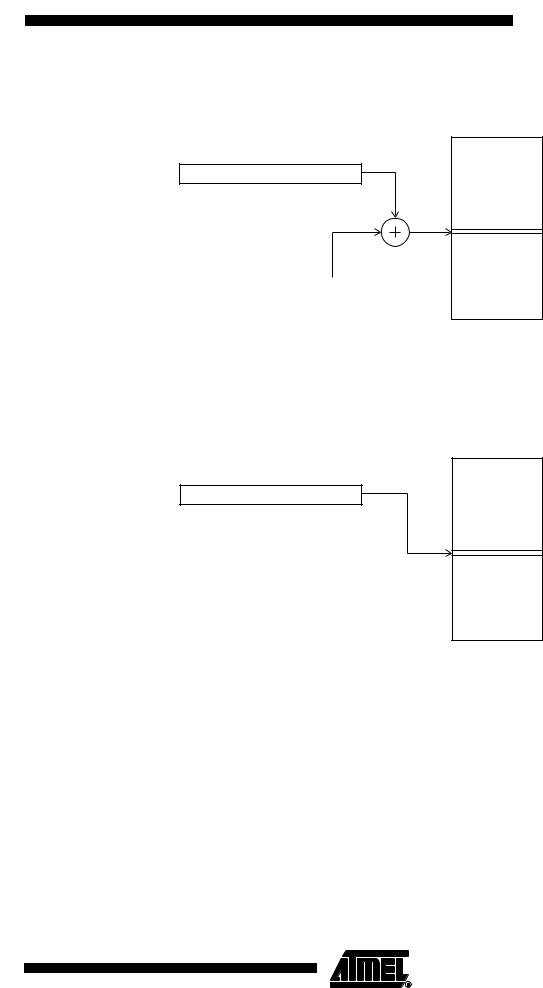
AVR Instruction Set
Data Indirect with Displacement
Figure 5. Data Indirect with Displacement
Data Space
0x0000
15 |
0 |
Y OR Z - REGISTER
15 |
10 |
6 |
5 |
0 |
|
|
OP |
Rr/Rd |
|
|
q |
|
|
|
|
|
|
RAMEND
Operand address is the result of the Y- or Z-register contents added to the address contained in 6 bits of the instruction word. Rd/Rr specify the destination or source register.
Data Indirect
Figure 6. Data Indirect Addressing
Data Space
0x0000
15 |
0 |
X, Y OR Z - REGISTER
RAMEND
Operand address is the contents of the X-, Y-, or the Z-register. In AVR devices without SRAM, Data Indirect Addressing is called Register Indirect Addressing. Register Indirect Addressing is a subset of Data Indirect Addressing since the data space form 0 to 31 is the Register File.
5
0856D–AVR–08/02
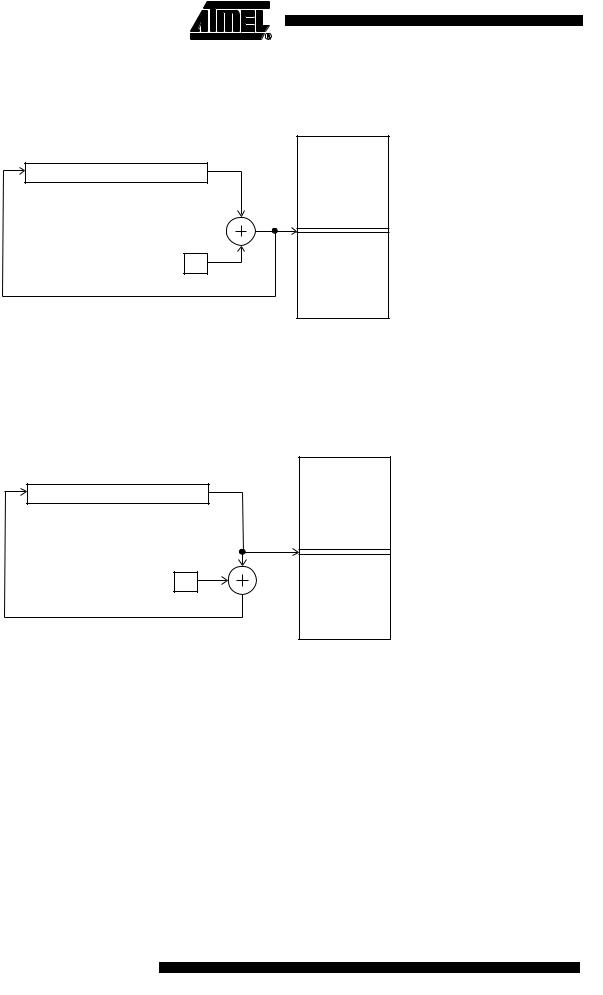
Data Indirect with Pre-decrement
Figure 7. Data Indirect Addressing with Pre-decrement
Data Space
0x0000
15 |
0 |
X, Y OR Z - REGISTER
-1
RAMEND
The X,- Y-, or the Z-register is decremented before the operation. Operand address is the decremented contents of the X-, Y-, or the Z-register.
Data Indirect with Post-increment
Figure 8. Data Indirect Addressing with Post-increment
Data Space
0x0000
15 |
0 |
X, Y OR Z - REGISTER
1
RAMEND
The X-, Y-, or the Z-register is incremented after the operation. Operand address is the content of the X-, Y-, or the Z-regis- ter prior to incrementing.
6 AVR Instruction Set
0856D–AVR–08/02
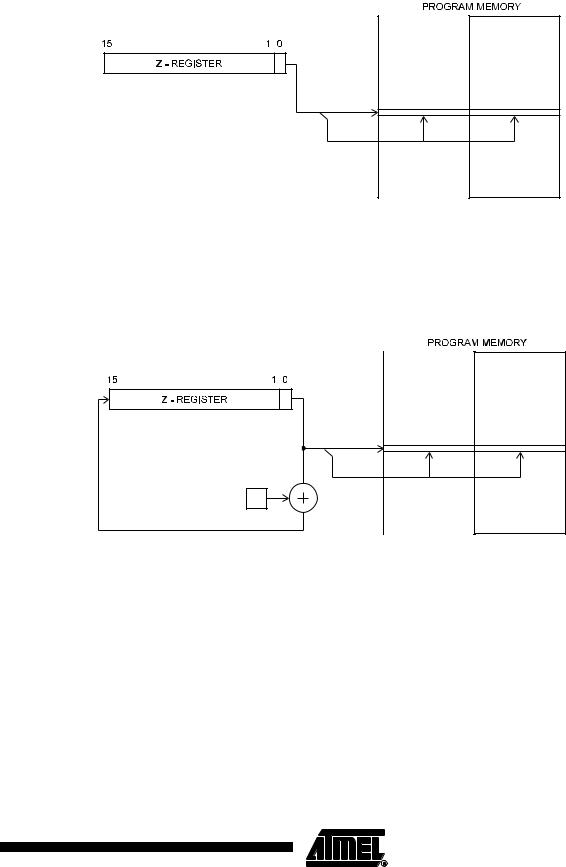
 AVR Instruction Set
AVR Instruction Set
Program Memory Constant Addressing using the LPM, ELPM, and SPM Instructions
Figure 9. Program Memory Constant Addressing
0x0000
LSB
FLASHEND
Constant byte address is specified by the Z-register contents. The 15 MSBs select word address. For LPM, the LSB selects low byte if cleared (LSB = 0) or high byte if set (LSB = 1). For SPM, the LSB should be cleared. If ELPM is used, the RAMPZ Register is used to extend the Z-register.
Program Memory with Post-increment using the LPM Z+ and ELPM Z+ Instruction
Figure 10. Program Memory Addressing with Post-increment
0x0000
LSB
1 |
FLASHEND
Constant byte address is specified by the Z-register contents. The 15 MSBs select word address. The LSB selects low byte if cleared (LSB = 0) or high byte if set (LSB = 1). If ELPM Z+ is used, the RAMPZ Register is used to extend the Z-register.
7
0856D–AVR–08/02
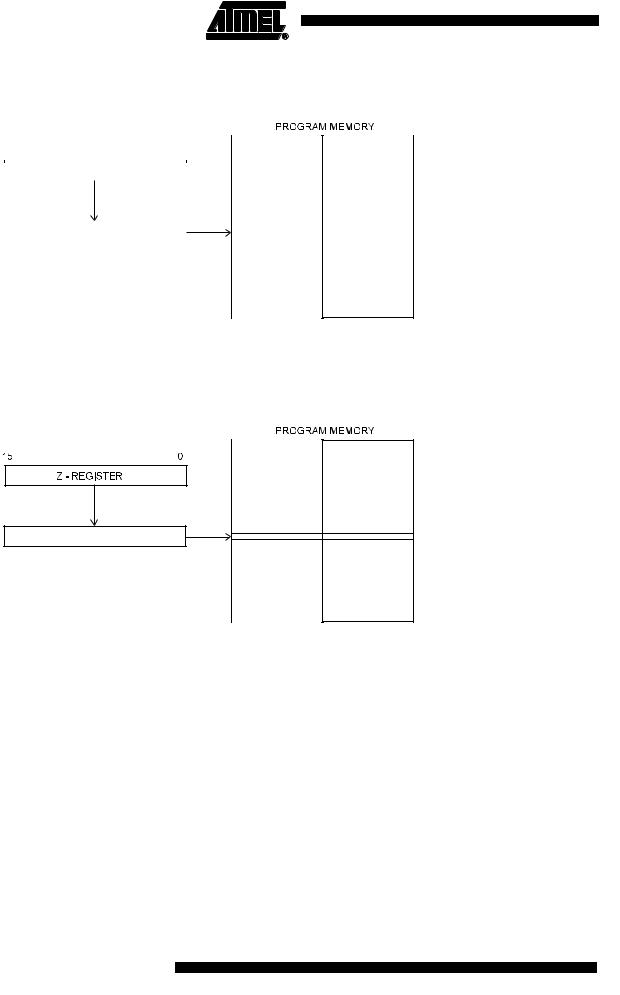
Direct Program Addressing, JMP and CALL
Figure 11. Direct Program Memory Addressing
|
31 |
16 |
|
|
0x0000 |
|
|
||||||
|
OP |
|
6 MSB |
|
|
|
|
|
|
|
|
|
|
|
|
16 LSB |
|
|
|
|
|
|
|
|
|
|
|
|
15 |
0 |
|
|
|
|
21 |
0 |
|
|
|
||
|
|
PC |
|
|
|
|
|
|
|
|
|||
|
|
|
|
|
|
|
FLASHEND
Program execution continues at the address immediate in the instruction word.
Indirect Program Addressing, IJMP and ICALL
Figure 12. Indirect Program Memory Addressing
0x0000
15 |
0 |
PC
FLASHEND
Program execution continues at address contained by the Z-register (i.e., the PC is loaded with the contents of the Z- register).
8 AVR Instruction Set
0856D–AVR–08/02
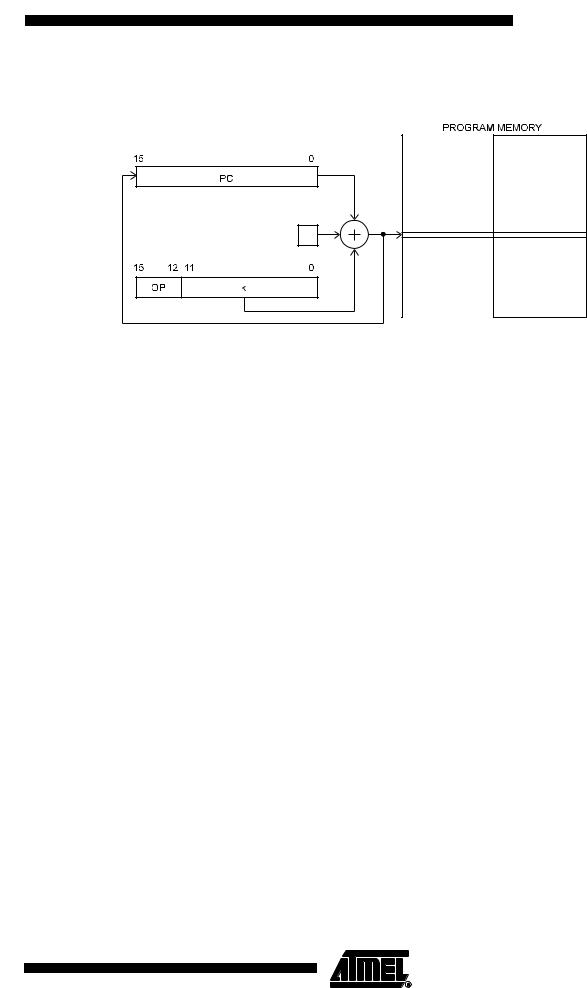
Relative Program Addressing, RJMP and RCALL
Figure 13. Relative Program Memory Addressing
1 |
AVR Instruction Set
0x0000
FLASHEND
Program execution continues at address PC + k + 1. The relative address k is from -2048 to 2047.
9
0856D–AVR–08/02
